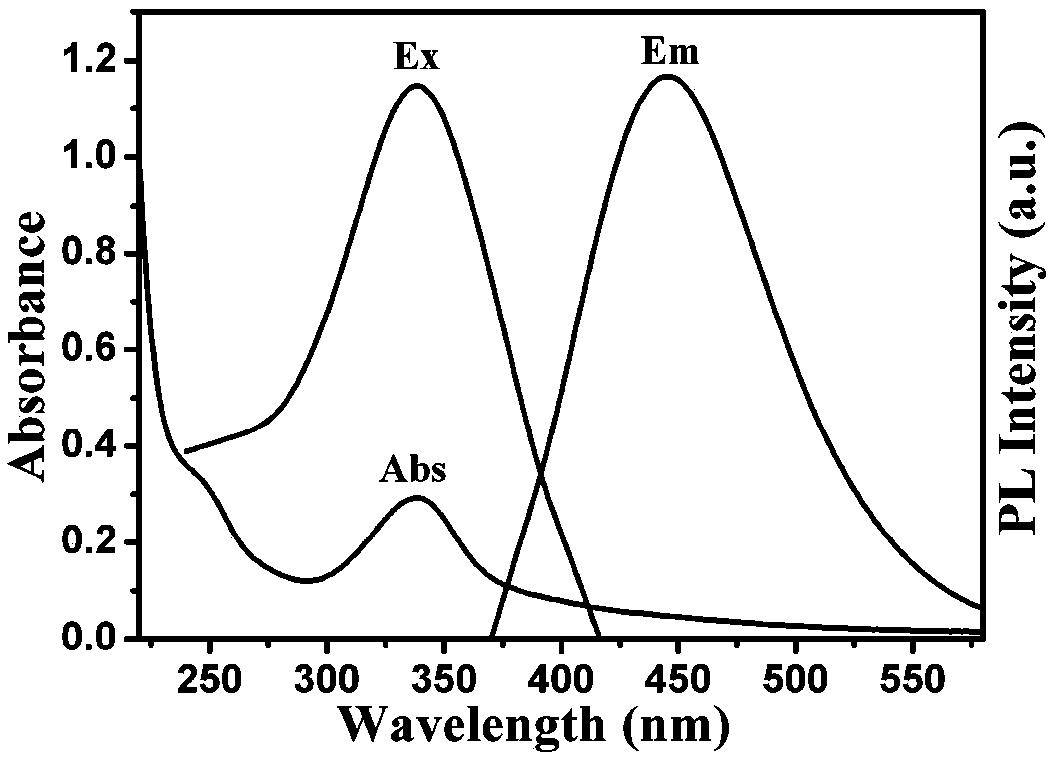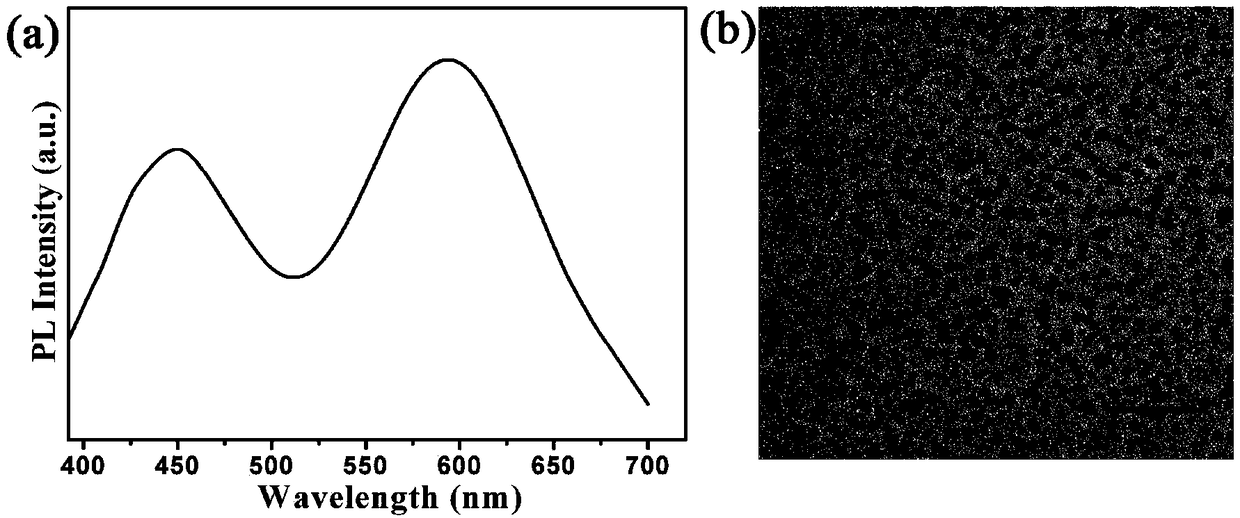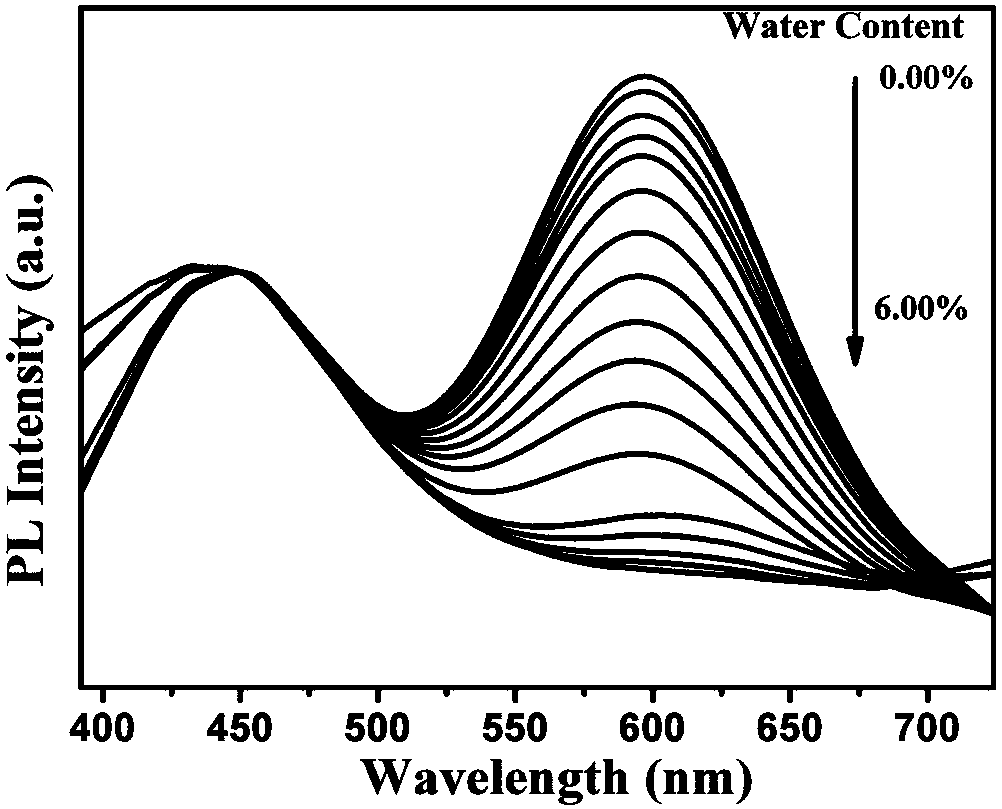Double-fluorescence-emission copper nano-cluster/carbon dot colorimetric probe, preparation method and application in trace water detection
A technology of copper nano-clusters and colorimetric probes, which is applied in the field of colorimetric sensing, can solve problems affecting detection results, etc., and achieve the effects of obvious detection effect, short time consumption, and simple preparation method
- Summary
- Abstract
- Description
- Claims
- Application Information
AI Technical Summary
Problems solved by technology
Method used
Image
Examples
Embodiment 1
[0030] (1) Synthesis of blue fluorescent CDs: Dissolve 1.0507g of citric acid and 335μL of ethylenediamine in 10mL of deionized water. Then the mixed solution was added to the Teflon reaction kettle, heated to 200° C. and reacted for 5 hours. After the reaction, it was naturally cooled to room temperature. The product is a brown-black transparent solution, a yellow solution is obtained after dialysis, and a light yellow CDs powder is obtained after freeze-drying.
[0031] (2) Synthesis of glutathione-modified CDs: 0.1995g glutathione (GSH) was added to 10mL of PBS (pH=6.86) buffer solution, and 1-(3-dimethylaminopropyl) was added to it )-3-Ethylcarbodiimide (EDC) (0.125g) and N-hydroxysuccinimide (NHS) (0.075g), the mixed solution was stirred at room temperature for 30min, protected from light, added 10mL to the concentration range of The 10 mg / mL CDs solution obtained in step (1) was then stirred at room temperature and protected from light for 10 hours, so that GSH-modified CD...
Embodiment 2
[0034] (1) Synthesis of blue fluorescent CDs: Dissolve 0.9603 g of citric acid and 300 μL of ethylenediamine in 8 mL of deionized water. Then the mixed solution was added to the Teflon reaction kettle, heated to 180°C and reacted for 6.5 hours, after the reaction, it was naturally cooled to room temperature. The product is a brown-black transparent solution, a yellow solution is obtained after dialysis, and a light yellow CDs powder is obtained after freeze-drying.
[0035] (2) Synthesis of glutathione-modified CDs: 0.1536g glutathione (GSH) was added to 8mL of PBS (pH=6.86) buffer solution, and 1-(3-dimethylaminopropyl) was added to it )-3-Ethylcarbodiimide (EDC) (0.0904g) and N-hydroxysuccinimide (NHS) (0.054g), the mixed solution was stirred at room temperature for 40min, protected from light, added 8mL to the concentration range of The 9 mg / mL CDs solution obtained in step (1) was then stirred at room temperature for 12 hours in the dark, so that GSH-modified CDs (GSH-CDs) w...
Embodiment 3
[0039] (1) Synthesis of blue fluorescent CDs: Dissolve 1.2359g of citric acid and 400μL of ethylenediamine in 12mL of deionized water. Then the mixed solution was added to the Teflon reaction kettle, heated to 160° C. for 8 hours of reaction, and after the reaction was over, it was naturally cooled to room temperature. The product is a brown-black transparent solution, a yellow solution is obtained after dialysis, and a light yellow CDs powder is obtained after freeze-drying.
[0040] (2) Synthesis of glutathione-modified CDs: 0.2033g glutathione (GSH) was added to 12mL of PBS (pH=6.86) buffer solution, and 1-(3-dimethylaminopropyl) was added to it )-3-Ethylcarbodiimide (EDC) (0.1652g) and N-hydroxysuccinimide (NHS) (0.947g), the mixed solution was stirred at room temperature for 60min, protected from light, added 12mL to the concentration range of The 12 mg / mL CDs solution obtained in step (1) was then stirred at room temperature and protected from light for 15 hours, so that G...
PUM
| Property | Measurement | Unit |
|---|---|---|
| Particle size | aaaaa | aaaaa |
Abstract
Description
Claims
Application Information
 Login to View More
Login to View More - R&D
- Intellectual Property
- Life Sciences
- Materials
- Tech Scout
- Unparalleled Data Quality
- Higher Quality Content
- 60% Fewer Hallucinations
Browse by: Latest US Patents, China's latest patents, Technical Efficacy Thesaurus, Application Domain, Technology Topic, Popular Technical Reports.
© 2025 PatSnap. All rights reserved.Legal|Privacy policy|Modern Slavery Act Transparency Statement|Sitemap|About US| Contact US: help@patsnap.com



